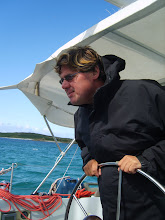Last Sunday, after we slept off the passage, we got some disturbing news. Six metre waves were coming our way! After some checking on various weather forecasting sites, it turns out a big storm is coming down from Greenland. It will reach the Azores on Thursday, which is today, and create 50 knot winds and 10 metre waves.
So what has that to do with us, who are a thousand Miles away from Flores, where the worst wil hit? Well, in two days time, the waves will have traveled South West to reach us, and still being over four Metres high, could prove somewhat unsettling. So we would have to mind this storm and the effects it has. And today, sure enough, the wind is howling in the Azores and on Saturday, we'll get almost 5 metre waves from the North West.
So what did we do? The first thing was to check for dangers in La Palma. The sea wall is strong enough, the harbour offering a lot of protection to the marina entrance and the berths are pretty wide and the pontoons strong. So we could always just stay.
Next up was to look for alternatives. The next port we could reach was around the East of La Gomera, so also protected from North Westerly swell. But we couldn't leave before Monday because the marina office is closed on Sundays, so then we'd have to leave early on Monday without having seen La Palma and find a berth in the marina in La Gomera.
From looking at Google Earth pictures, this looks like a well protected marina, but alas with only some free berths near the entrance. So any swell would likely affect those spots worst. On top of that, the berths aren't that wide, so big swell could lead to some damage from adjacent boats.
So the next alternative is Tenerife. About a 110 Miles further East, but offering very good protection. But the forecast for Monday until Thursday was light winds, so we'd probably have to motor all the way there. There is some wind predicted for Friday, but that's cutting it a bit fine with the swell coming in Friday night.
And of course with the ARC coming up, all the Eastern ports fill up quite rapidly. Perhaps combined with the storm, we might find there is no more room in Tenerife either, though that's not very likely. So it was a long 24 hrs motoring to Tenerife, or staying put and making the best of it.
So this is what we've chosen to do, we'll leave for Gomera next Monday and since we don't have to be in Tenerife until next Thursday, that gives us some time to visit before we leave for San Miguel on Tenerife.

Until then, we deploy all mooring lines and hope the marina poles are well anchored.
